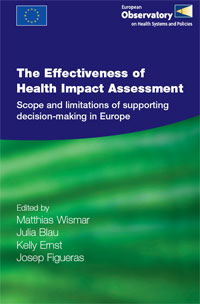 |
THE EFFECTIVENESS OF HEALTH IMPACT
ASSESSMENT
Scope and limitations of supporting
decision-making in Europe
Edited by Matthias Wismar, Julia Blau, Kelly Ernst,
Josep Figueras
World Health Organization, 2007, 321 pages
|
http://www.euro.who.int/document/E90794.pdf?language=Russian
Оценка воздействия на здоровье (ОВЗ) представляет собой
инструмент, применяемый в поддержку принятия решений и проведения
политики на межсекторальном уровне. Он позволяет оценить потенциальные
последствия "непринятых решений" для здоровья. Генерируемая
таким образом информация может быть использована для выбора оптимальных
действий.
В книге приведена детальная картина применения ОВЗ в
Европейском регионе ВОЗ в самых различных сферах, таких как транспорт,
экология, городское планирование, сельское хозяйство, и на различных
уровнях - национальном, региональном и местном. В ней также содержится
обзор процессов внедрения и институционализации ОВЗ с особым вниманием
к аспектам стратегического управления, финансирования, создания
ресурсов и достижения конечных результатов.
С использованием стандартных аналитических подходов
проведена оценка эффективности ОВЗ на 17 примерах из практики. По
результатам этого анализа обозначены факторы, влияющие на эффективность
ОВЗ.
В целом, из содержания книги следует, что ОВЗ может
применяться с эффективностью, и в то же время в ней продемонстрирована
неравномерность развития и неполная институционализация ОВЗ в различных
странах Европы.
Монография базируется на результатах европейского научно-исследовательского
проекта, финансированного в рамках Программы работы в области общественного
здравоохранения Европейского союза. Эта работа, в которой приняли
участие исследовательские группы из 19 стран, была выполнена под
руководством Европейской обсерватории по системам и политике здравоохранения.
Contents
List of tables, figures and boxes ix
Foreword
Robert Madelin
Acknowledgements
Contributors
Why research HIA? An introduction to the volume
Matthias Wismar
Part I: Health Impact Assessment: Key Issues, Research
and Results
Chapter 1: What is HIA and why might it be useful?
John Kemm
Chapter 2: Is HIA effective? A synthesis of concepts, methodologies
and results
Matthias Wismar, Julia Blau and Kelly Ernst
Part II: The European Map of Health Impact Assessment
Chapter 3: The use of HIA across Europe
Julia Blau, Kelly Ernst et al.
Chapter 4: Implementing and institutionalizing HIA in Europe
Matthias Wismar, Julia Blau et al.
Part III: The Effectiveness of Health Impact Assessment:
Case Studies
Case study 1: A large-scale urban development HIA: focusing on
vulnerable groups in London, England
Katie Collins and Lorraine Taylor
Case study 2: Ecosystem revitalization: community empowerment
through HIA in Tuscany, Italy
Roberta Siliquini, Nicola Nante and Walter Ricciardi
Case study 3: A local-level HIA in the transport sector: following
legal requirements in Lithuania
Marius Stricka, Ingrida Zurlyte and Vilius Grabauskas
Case study 4: HIA and intersectoral policy in urban planning:
a checklist for health impact screening in Leiden, the Netherlands
Janneke van Reeuwijk-Werkhorst and Loes van Herten
Case study 5: A city council's air quality action plan: building
capacity for HIA in Northern Ireland
Teresa Lavin and Owen Metcalfe
Case study 6: Using intersectoral networks towards the adoption
of the Common Agricultural Policy: an HIA on the Food and Nutrition
Action Plan in Slovenia
Mojca Gabrijelcic Blenkus and Nina Scagnetti
Case study 7: A private sector HIA initiative: a smoke-free workplace
policy in Spain
Francisco Barroso
Case study 8: HIA speeding up the decision-making process: the
reconstruction of route 73 in Sweden
Ida Knutsson and Anita Linell
Case study 9: Citizen involvement in a local HIA: informing decisions
on the future of a landfill site in Wales
Eva Elliott, Alison Golby and Gareth Williams
Part IV: The Effectiveness of Integrating Health in Other Impact
Assessments: Case Studies
Case study 10: A participative social impact assessment at the
local level: supporting the land-use planning process in Finland
Kirsi Nelimarkka, Tapani Kauppinen and Kerttu Perttil?
Case study 11: The controversial Berlin Brandenburg International
Airport: time- and resource-consuming efforts concerning health
within planning approval in Germany
Rudolf Welteke, Thomas Classen, et al.
Case study 12: "Buzz" around electromagnetic fields:
a lengthy environmental HIA in Poland
Anicenta Bubak and Ewa Nowak
Part V: The Effectiveness of Elements of Health Impact Assessment:
Case Studies
Case study 13: Pushing the agenda among decision-makers: an international
assessment of transport-related health effects in six countries
Martin Sprenger and Ursula P?ringer
Case study 14: Contributing to a public health culture: health
and economic impacts of a health promotion campaign in Denmark
Gabriel Gulis
Case study 15: Removing hurdles towards HIA: pilot project of
an obstacle-free environment in Hungary
Edit Eke
Case study 16: Traffic and transport at the local level: capacity
building for HIA in Ireland
Teresa Lavin and Owen Metcalfe
Case study 17: Moving towards the development of an HIA methodology:
the effects of air pollution in Ticino, Switzerland
Konrade von Bremen
|

